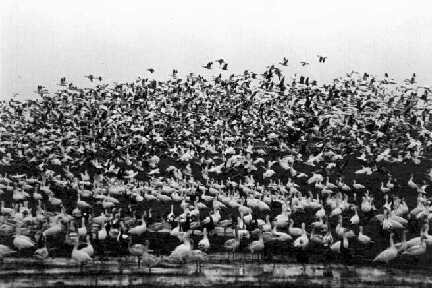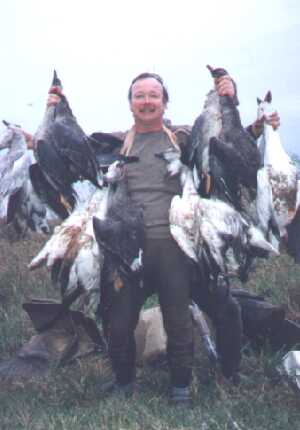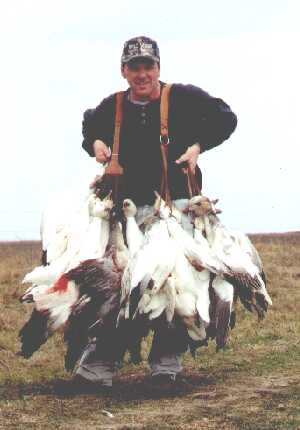Texas Goose Hunting
1A Hunting in Texas Guide Service
Texas is the winter home to literally millions of waterfowl. Among them are snow goose, blue, ross, specklebelly or whitefronted goose, and lesser canada geese. We get all of those species on our hunting properties; often in HUGE numbers! That makes for great Texas goose hunting!
We offer guided goose hunts near Bay City, Texas, and northeast of Waco, Texas.
The picture on left was taken on one of our feeding fields near Bay City.
The picture on right is one of the roosts lifting off near Waco.


CALL US at 210-872-2771
NEWS: Texas duck and goose seasons to be the most liberal in over a decade.
Click here to read more:
Proof that Texas goose hunting can be AWESOME!
Sign up for our upcoming goose cook off to benefit Texas kids in need co-sponsored by Mullen & Mullen in Dallas


RECIPES
- Crockpot Soup
- Goose with Apple
- Dressing
- Goose Chili, 1 alarm
- Goose and Dumplings
- Honker Kabobs
- Stuffed Wino Honker
- Plum Glazed Fowl
- Fruity Roast Goose
- Oriental Sweet and
- Sour
- Goose Gumbo
INFO
- Identify Texas Geese
- Know the Federal
- Laws
- International
- Migratory Bird Treaty
- Know Texas Goose
- Hunting Laws
- Federal Waterfowl
- Count Info
- Learn About the
- “Duck Stamp”
- Cleaning and Processing
- Goose Hunting Tips and Tactics
- Decoying Snow Geese
- Goose Hunting Links
- When to Call the Shot
Clean and Process Your Birds
All too often, when I take clients out goose hunting in Texas, they try to give me all the birds when we are done shooting for the day. I like to eat goose, and so does my family, but we can only eat so many a year. Y’all need to take home your birds. The main reasons I hear for not wanting the birds is that they taste bad, the hunter doesn’t know how to clean them, or they think that cleaning them is too much work. Here is the “how to” of cleaning and processing ducks and geese to make it as easy as possible, and make them taste as good as possible.
.
Plucking, The Hardest Way, But NOT that Hard!
If you decide to pluck them, for cooking whole, It is MUCH easier to get it done if you first dunk them in very hot water that has some parrafin melted into it. The hot water expands the pores around the feather bases and lets them come out easier. The parrafin wax will keep feathers from blowing all over, and lets them peel off the skin like a coat. Be VERY CAREFUL when dunking the birds into the water so as not to get burned. Use insulated tongs to hold the goose, or a similar device. Also let the wax cool a minute or two to avoid burning yourself. When removing entrails, be sure to get ALL of them, including the dual spleens, which are packed tightly along each side of the backbone, behind the guts. A baby spoon will help get these organs out of the cracks between the ribs where they connect to the backbone. Your finger tip will work, too, but watch out for broken bones. THEY HURT when they poke you.
.
Breasting, Pretty Darned Easy, Actually!
Shears can make breasting easy! Flip the goose onto it’s breast and use the shears to cut along both sides of the backbone from head to tail. Then just grab the head and pull hard to remove all the entrails along with the backbone, head, neck and tail. All that’s left to do is to peel off the skin from the breast, cut off the wings and pull the legs, if desired. The law requires that at least one fully feathered wing or head remain attached until the bird reaches it’s “final destination”. This is an easy way to fulfill that requirement but reduce the volume of your haul for transport.
.
Filleting, Easy AND Fast!
To fillet out the breast meat easily, place the bird, back down, on the edge of table with it’s head hanging off the near side. Grip the skin firmly where the breast makes a dip at the base of the neck (the craw). Rip this skin downward a bit. Turn the goose head away from you and peel the skin off the breast, working from the ripped craw toward the sides and belly of the goose. Stop skinning when the breast is clear, You do not have to completely remove the skin from the carcass. Now, with a fillet knife, make a deep slice along each side of the breast bone. Continue filleting along both sides of the breast plate until the fillet comes loose from there, finish removing by cutting loose from the wishbone.
.
Finishing Touches, To Make ‘Em Taste Good!
Many people complain about the liver like taste of goose, or greasiness. The taste can be made MUCH milder by getting as much blood out of the meat as possible. Wash the cleaned birds thoroughly, squeezing out the blood. Then soak the geese in refrigerated water for at least a full day. Change the water at least three times, and put just a little vinegar in the water (less than a teaspoon) with each change. Only birds cooked with the skin on might be greasy. All fat is between the skin and meat. Truth is, if you are cooking skinless goose meat, you will usually have to add bacon wraps or something like that to keep it from getting too dry. For skin on cooking, just cut a few small slits through the skin along the underside. This will allow the melted fat to drain off as you cook.